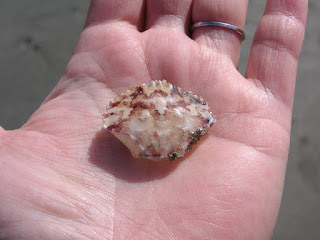 rock crab carapaces
rock crab carapacesCancer spp.
The interior of Cancer carapaces are amazingly colorful. These almost look like they've been filled with Easter egg dye and sand.
This post was very challenging to research, hence it's link-laden. According to the California Department of Fish and Game, we have 9 species of Cancer crabs. I used an old edition of Light's Manual: Intertidal Invertebrates of the Central California Coast sent to me by Steve at Blue Jay Barrens (Thanks again, Steve!), which listed only 8 species and keyed 6 of those.
I'm attempting to ID based solely on the carapaces, which is the most common body part I saw washed up on the beach. Everything I found were 1-3" in width. Since crabs molt, size is not a significant indicator of a species. I spent quite a bit of time zooming in on each of the photos and counting the carapace spines/teeth. There is very little information online for some of the smaller species. If you're curious to learn more, make sure to click on the embedded links under each photo.
This post was very challenging to research, hence it's link-laden. According to the California Department of Fish and Game, we have 9 species of Cancer crabs. I used an old edition of Light's Manual: Intertidal Invertebrates of the Central California Coast sent to me by Steve at Blue Jay Barrens (Thanks again, Steve!), which listed only 8 species and keyed 6 of those.
I'm attempting to ID based solely on the carapaces, which is the most common body part I saw washed up on the beach. Everything I found were 1-3" in width. Since crabs molt, size is not a significant indicator of a species. I spent quite a bit of time zooming in on each of the photos and counting the carapace spines/teeth. There is very little information online for some of the smaller species. If you're curious to learn more, make sure to click on the embedded links under each photo.
 best guess hairy rock crab
best guess hairy rock crabbest guess Cancer jordani (aka Romaleon jordani)
While I may have linked to these above, here, by name, are the best photographic crab ID sites I've found for the west coast of North America:
Crab Identification @ Oregon Department of Fish and Wildlife
Key to Family Cancridae--Cancer Crabs @ Walla Walla University
Intertidal Invertebrates of the Monterey Bay Area @ University of California, Santa Cruz
Rocky Shore Crustaceans @ Seanet, Stanford University (also check out Subtidal Crustaceans)
Crab Identification @ Oregon Department of Fish and Wildlife
Key to Family Cancridae--Cancer Crabs @ Walla Walla University
Intertidal Invertebrates of the Monterey Bay Area @ University of California, Santa Cruz
Rocky Shore Crustaceans @ Seanet, Stanford University (also check out Subtidal Crustaceans)
Crustacea of Southern California @ University of California, Irvine
Odd thing about me, whenever I see a crab, I always get a sudden hunkering to eat them with lots of butter. I'm not kidding. Here are other links that caught my interest:
Baby Crab Eater @ The Drop-In to Moss Landing Marine Labs blog
Crabfest 2011 @ The Monkeyface News blog
California Fisheries Atlas - Rock Crabs @ California Fisheries Fund
Don't Hang Up Those Hoop Nets Just Yet - Crab Season is Year Round @ Western Outdoors News
Odd thing about me, whenever I see a crab, I always get a sudden hunkering to eat them with lots of butter. I'm not kidding. Here are other links that caught my interest:
Baby Crab Eater @ The Drop-In to Moss Landing Marine Labs blog
Crabfest 2011 @ The Monkeyface News blog
California Fisheries Atlas - Rock Crabs @ California Fisheries Fund
Don't Hang Up Those Hoop Nets Just Yet - Crab Season is Year Round @ Western Outdoors News
ps - For a little bit of gutter humor, as I was researching the IDs above using the old Light's Manual and with selective choice of spp. and words... I discovered pee crabs, er, pea crabs (Pinnixa spp. and others) live in penis fish (Urechis spp.) burrows. Haha, who knew!?!



1 comment:
Great post. I love that first colorful shot!
Post a Comment